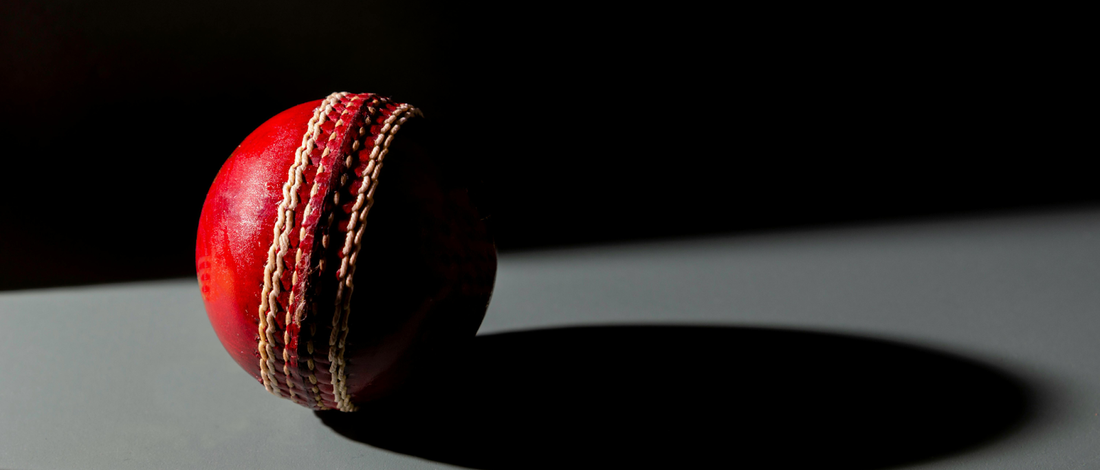Key Takeaways:
- Material Composition Matters: Cricket balls are constructed using a cork core, wound yarn, and stitched leather, each chosen for strength and performance.
- Craftsmanship Influences Play: The craftsmanship — including hand stitching, pressing, and polishing — directly affects the ball’s movement and longevity.
- Color Types Suit Game Formats: Different formats use red, white, or pink balls to suit visibility needs and playing conditions, each tailored for specific game types.
At Cricket Store Online, we pride ourselves on being the USA's largest cricket gear supplier, dedicated to providing premium quality equipment to players of all levels. Our journey, rooted in a deep love for cricket, has evolved from humble beginnings into a trusted destination for cricket enthusiasts nationwide.
A cricket ball is not just a piece of equipment; it's a marvel of engineering and craftsmanship. From the choice of materials to the meticulous construction process, each aspect plays a crucial role in the game's dynamics. Understanding the intricacies of cricket ball manufacturing offers players and enthusiasts a deeper appreciation for the sport and its equipment.
In this piece, we will be discussing the materials and craftsmanship that go into making cricket balls, shedding light on their impact on performance and durability.
Core Materials Used In Cricket Balls
At first glance, a cricket ball may seem like a simple object, but it's actually made of multiple carefully selected materials, each serving a specific purpose to enhance performance, durability, and consistency. When it comes to top-tier cricket balls, Cricket Store Online sets the standard. Our products are crafted with expert precision and tested for excellence. Shop now and experience unmatched performance on the pitch.
Cork Core
At the heart of every cricket ball is a small core made from cork, often layered or mixed with rubber. This core provides the hardness and bounce essential for the ball’s behavior during play. Cork is chosen for its resilience — it compresses upon impact and quickly returns to shape, helping the ball maintain performance over time.
Wound Yarn Layer
Surrounding the cork core is a tightly wound layer of wool or polyester yarn. This layer adds bulk to the ball and helps absorb shock. It also contributes to the ball’s weight and balance, playing a subtle yet critical role in how the ball travels through the air and off the pitch.
Leather Casing
The most visible and iconic part of a cricket ball is its leather outer casing, typically dyed red or white depending on the format of the game. The leather is usually made from cowhide and undergoes a tanning and dyeing process to enhance its durability and weather resistance. The two halves of leather are stitched together with a prominent seam using heavy-duty linen or polyester thread.
Polish Or Wax Finish
Once stitched, the leather is treated with polish or wax, giving the ball its glossy finish. This not only protects the leather but also aids in swing bowling, as players maintain the shine on one side to manipulate aerodynamics.
The Craftsmanship Behind A Cricket Ball
The creation of a cricket ball is a skilled, multi-step process that combines traditional methods with precise craftsmanship. While machines may assist in some parts of production, much of the ball's quality still depends on the hands of experienced artisans.
Shaping The Core
The process begins with forming the cork and rubber mixture into a compact sphere. This core must be perfectly round and balanced. The consistency of the core affects the bounce and weight distribution of the ball, which in turn impacts performance.
Winding The Yarn
Once the core is shaped, it is tightly wound with several layers of yarn, often done under tension to ensure uniformity. This winding is crucial for giving the ball its bulk, weight, and shock absorption qualities. Consistency in the winding process ensures the ball behaves predictably in play.
Cutting And Stitching The Leather
The leather is cut into two pieces known as “quarters.” These quarters are shaped into hemispheres, soaked, dyed, and molded to fit snugly around the yarn-wound core. Stitching these halves together is a highly skilled step. The seam — consisting of six rows of prominent stitching — is a defining feature of cricket balls, aiding bowlers in grip, swing, and spin.
Pressing And Polishing
After stitching, the ball is pressed into a perfectly round shape using a metal mold or press. This compression locks all components into place. Finally, the leather is polished or waxed to seal it, enhance shine, and provide initial protection against moisture and wear.
Types Of Cricket Balls And Their Differences
While the basic structure of cricket balls remains the same across the board, different formats, conditions, and manufacturers result in distinct types of balls, each with unique characteristics. The three most common types are red, white, and pink cricket balls, but there are also variations in craftsmanship and brand-specific traits.
Red Cricket Balls
Red balls are traditionally used in long-format games, such as Test matches. Known for their durability and ability to aid reverse swing as the match progresses, red balls are made from naturally tanned leather and are polished with a layer of grease or wax. Their darker color helps them remain visible in daylight but becomes harder to spot under artificial lighting.
White Cricket Balls
White balls are primarily used in limited-overs formats, like One Day Internationals (ODIs) and T20s. They are manufactured in the same way as red balls but with a different dye and finish. Due to their color, they’re more visible under floodlights and with colored player kits. However, white balls tend to deteriorate faster, losing their shine and shape quicker than red ones, which is why two balls are often used in ODIs.
Pink Cricket Balls
Pink balls are a relatively modern innovation introduced for day-night Test matches. They’re designed to retain visibility under varying lighting conditions, combining features of both red and white balls. The leather is treated with a distinct pink dye and often given a more robust finish to preserve the color and surface throughout long sessions.
Why Materials Matter: Performance And Durability
The materials used in cricket balls aren't chosen at random — they are critical to the ball’s performance, feel, and longevity. Whether it's a Test match that stretches over five days or a high-intensity T20 game, the construction and components of a ball directly affect how it behaves and how long it lasts. Serious players choose Cricket Store Online for their cricket balls because quality matters. Our selection includes the finest materials and craftsmanship for game-ready reliability. Don’t settle—gear up with the best.
Impact On Swing And Spin
The leather cover, seam construction, and surface polish all influence how a ball moves through the air. A well-stitched seam and high-quality leather help bowlers grip the ball better and create more pronounced swing or spin. The condition of the leather — whether it’s shiny, rough, or scuffed — plays a key role in manipulating the ball mid-air.
Durability Across Formats
Test matches demand balls that can withstand up to 80 overs of play. In these cases, red balls with thicker seams and more durable leather are preferred. In contrast, limited-overs games require balls that remain highly visible but don’t necessarily need to last as long, hence the use of white balls that may be changed more frequently due to wear and discoloration.
Consistency Aand Fair Play
Using high-quality materials ensures uniformity in bounce, flight, and seam behavior, which contributes to fair competition. Inferior materials can lead to unpredictable ball behavior, giving an unfair advantage or disadvantage to bowlers or batters.
Adaptation To Conditions
Balls made with harder leather and tighter seams tend to perform better in hot, dry climates, while softer materials may be more suited for damp or overcast conditions where swing plays a greater role. Manufacturers often tailor their balls to suit the environments in which they are primarily used.
Final Thoughts
Cricket balls are far more than a simple sphere of leather — they represent a unique blend of traditional craftsmanship, material science, and sporting heritage. From the cork core at their center to the polished leather surface on the outside, each component is carefully selected and assembled to serve a distinct purpose on the field.
The choice of materials affects every aspect of a ball’s behavior — how it swings, spins, bounces, and endures. The stitching, shape, and finish reflect the skills of craftspeople who understand that even the smallest flaw can influence the outcome of a match.
As the game continues to evolve, the cricket ball remains a constant symbol of the sport’s integrity and precision. Understanding what goes into making one not only deepens appreciation for the game but also highlights the unseen details that make cricket the strategic, nuanced sport that fans around the world cherish.
Read also:
- Best Practices for Cricket Bat Care: Prolonging Your Bat's Lifespan in 2025
- Cricket Rules Explained: Understanding The Game’s Essentials
- Cricket’s Rise in America: What Players Need to Know in 2025
Frequently Asked Questions About What Cricket Balls Are Made Of
Why are cricket balls so hard compared to other sports balls?
Cricket balls are designed to be hard to maintain their shape and performance over extended periods. The hardness helps in generating bounce, pace, and spin, and also makes them suitable for the physical demands of cricket, which can involve up to 80 overs in a match.
Can cricket balls be made without leather?
While traditional cricket balls use leather, there are synthetic alternatives often used in training or junior-level cricket. These synthetic balls mimic the feel of leather but are cheaper and require less maintenance.
How long does it take to make a single cricket ball?
Crafting a high-quality cricket ball typically takes several hours. From shaping the core and winding yarn to cutting, stitching, pressing, and polishing the leather — the process is both time-consuming and labor-intensive.
Why do cricket balls have a prominent seam?
The raised seam serves both a functional and tactical purpose. It helps bowlers grip the ball and manipulate swing and spin, especially in longer formats where subtle ball movement is key.
Do temperature and humidity affect cricket balls?
Yes, weather conditions can significantly impact the behavior of a cricket ball. In humid or overcast conditions, the ball may swing more, while in dry heat, it can deteriorate faster and become more abrasive, assisting reverse swing.
Is the inside of a cricket ball hollow?
No, cricket balls are not hollow. The core is solid, usually made from compressed cork or cork and rubber, and wrapped in yarn before being encased in leather.
Why are different colored cricket balls used in the same sport?
Different colors are used for visibility under various lighting conditions. Red is ideal for daylight, white works best under artificial lights, and pink combines both for day-night matches.
Are all cricket balls the same size and weight?
While there are international standards, slight variations exist based on the ball's intended use — men’s, women’s, or junior cricket. Regulations ensure the differences are minimal to maintain fairness.
Can a cricket ball be recycled or reused?
Old or damaged balls are usually not recycled into new ones. However, they are often repurposed for practice sessions or used in training drills.
What makes one brand of cricket ball better than another?
Differences in leather quality, seam construction, hand vs. machine stitching, and finishing techniques influence durability, grip, and performance. Some brands are preferred based on playing conditions and regional preferences.





